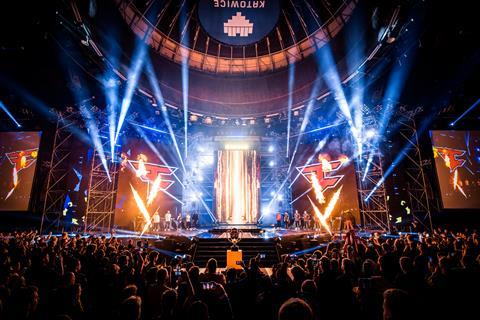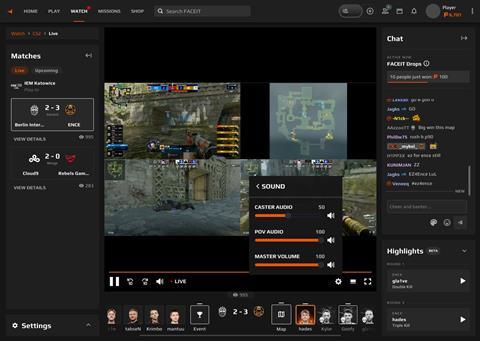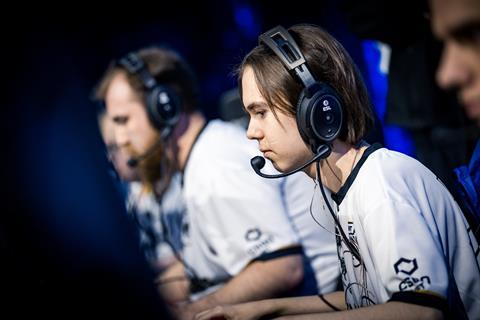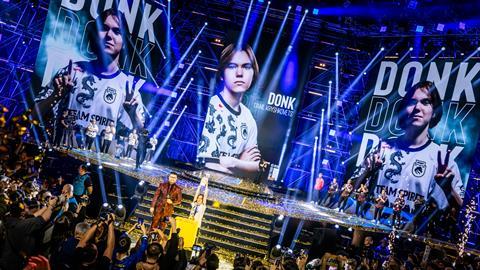Could a proprietary live-streaming platform unlock key commercial opportunities in the esports domain? Dan Symonds reports.
Esports trailblazer ESL FACEIT Group (EFG) sent shockwaves through the sector at the end of February after announcing that it would reduce its workforce by roughly 15%.

Co-CEO’s Craig Levine and Niccolo (Nic) Maisto said that the difficult decision had been taken to “support EFG’s sustainable growth ambitions and profitability” and would ultimately “sharpen [the company’s] focus, and better equip [EFG] to navigate the dynamic esports and gaming landscape.”
While there’s no doubt that EFG is not alone in streamlining its business (one only needs to look to the mass M&E layoffs dominating the first quarter with the likes of Channel 4, Twitch/Amazon, and Paramount Global, among others), many had been surprised given EFG’s leading position in the market and the wealth of its parent company - Savvy Games Group, which is owned by Saudi Arabia’s Public Investment Fund (PIF).
The potential of the esports sector is a clear draw for investors such as Savvy, yet for all its potential, esports is still a work in progress and one that struggles to strike the right balance between fan engagement and commercialisation. With the absence of a silver bullet, many esports businesses continue to evolve and experiment in a bid to achieve profitability.
FACEIT Watch
As EFG continues to make changes following the ESL FACEIT merger and Savvy acquisition, the launch of its very own streaming platform - FACEIT Watch – could prove to be a highly significant step in the long-term transformation of the business.

Designed in collaboration with OTT tech developer Znipe Esports, the FACEIT Watch streaming platform provides users with a selection of tools that enable them to tailor their viewing experience, all the while being freely available for anyone to access.
The development of FACEIT Watch is being headed by Warren Leigh, Senior Vice President of Product, Digital Platforms, who joined EFG last summer.
Leigh, a self-confessed techie and gaming enthusiast, has essentially gone full circle, spending more than a decade producing video games for the likes of Sega and Activision, before developing streaming platforms with Amazon and DAZN. Returning to gaming, albeit for a new audience segment, FACEIT Watch presented an opportunity to combine Leigh’s experience to date and produce a distinct streaming experience for a new generation of gamers.
“Whenever you step into a new segment like esports you’ve got to go and speak to the fans and find out what they want, what they’re looking for that’s different, what they’re not getting on YouTube or Twitch, and how we can build a platform for them,” he enthuses. “We’ve got a lot of people here that are industry pioneers, people who were players, and that started the industry because of their passion. So there are lots of people here who know esports thoroughly, but still, you can’t just take one side, you have to spend a lot of time talking to people about how you can build something different for esports fans.
“So that’s where a lot of time was spent in the early days, trying to work out how we could be different, but also, be in tune with esports fans and deliver something bespoke and unique to them that generalist or other platforms weren’t able to support,” Leigh says.
Read more Esports world cup unveils mobile legends: Bang Bang as first partner title
You’re in control
Featuring a unique multi-perspective view selector, FACEIT Watch enables users to have up to four screens playing at any given time, where they can select their favourite players’ perspectives and run them next to the main event stream.

“So you’ll have the main broadcast feed coming in, featuring the commentators and showing the most important things that they think are going on,” says Leigh. “But you’ll also have the POV functionality, the scores and chats, the kill cams in the top right that are automated and can be replayed, and also the highlights section down the bottom, which also automates the highlights of any double kill or other key moments.”
Users can even adjust the volume of caster and multi-perspective sounds, as well as disable spoilers.
“All of this puts a lot of power into the user’s control and allows them to choose what they see,” adds Leigh.
The result is a user interface that resembles something closer to the control panel of a real-time strategy (RTS) game like Dota 2 rather than a traditional broadcast feed. But how would that be received in reality?
The big stage
FACEIT Watch was rolled out for EFG’s flagship event, IEM Katowice, which took place from 9-11 February. The annual competition sees the world’s best Counter-Strike 2 teams battle it out for a share of a $1m prize pool.
“During Katowice, there was a great narrative that happened with Team Spirit that came out of nowhere,” shares Leigh.
In the final, Team Spirit, ranked 19th in the ESL World Rankings, beat the top-ranked side FaZe Clan in a decisive 3-0 victory. Making his Tier 1 professional debut, 17-year-old prodigy Danil “donk” Kryshkovets produced arguably one of the best individual performances in Counter-Strike history.
“Donk was already at the top of our leaderboards in terms of the rankings, but for Team Spirit, a relatively new team coming through to go on and do that, on the big stages, it was a bit of a shock story,” explains Leigh.
“Over the course of the tournament people were hearing a lot about Team Spirit and donk but maybe didn’t know who they were,” Leigh continues. “They were logging onto the Watch platform and clicking on donk to see how he plays, and were like, “this guy is awesome right?” They were really getting into the fact that they could see the talent on display from this new story that was coming through.
“So it was a nice demonstration of the FACEIT Watch platform, to see the fan engagement around the story and how the features we were building were really working for people to get behind the scenes and see that story going on,” he says.
While the esports and live sports spaces have a history of borrowing from one another, Leigh understands that the POV approach may not translate to sports fans.
“From an esports fan’s perspective, the features were things that people were asking for that they don’t traditionally get,” he says. “Now would that marry to traditional sports? Would you want to follow a player around? I think Sky and a few broadcasters have tried some of that before with maybe less traction, but we’re seeing that this really resonates with gamers.”
Commercial potential
Watch currently features a live stream from the tournament broadcast, which in turn goes out on platforms such as Twitch and YouTube. But are there plans to change this dynamic in future and how is the live broadcast being leveraged to direct traffic to the Watch platform?
“There were a few callouts and we had some of our spot commercials or awareness campaigns shown during some of the breaks, so we were starting to educate people or at least raise awareness that we’re building something for them over here and they should come and check it out,” says Leigh. “I think because we’re building that broadcast feed and we have the production teams on the ground, there’s going to be a deeper connection there around ideas that they might want to see, and if they could control and build a broadcast tool or a way to engage with their fans as well, then we can work together on something that maybe isn’t working for them under the other platforms, or that they feel that doesn’t work on those other platforms.
“There’s no push for us to turn this content exclusive,” stresses Leigh. “I want to make that clear, in terms of Twitch and YouTube or some platforms, I love them to bits, use them all the time myself, and they’re great at what they do. We’re just trying to offer something different and if we can find ways that offer something unique and different to people, we’re going to look and find that.”
While there are no plans to create exclusive content for FACEIT Watch, the commercial potential for leveraging ad-tech and other sponsorship opportunities is clear to see, with limited advertising already included at this early stage.
“We obviously do need to run a business here and we’re going to have to look at the ways that we do that,” concedes Leigh. “But there are no plans to paywall content. I don’t think that’s right for esports and I don’t think that’s the way the industry is going. Right now, there is advertising on our FACEIT platform, and there is advertising in our other video aspects. I think we need to be very careful about how we find those non-intrusive moments inside the sport to put some advertising in there. We’re definitely not going to put it in the middle of the action and destroy the action, which is the most important thing, so that’s paramount. But then building an advertising model that might work around that, for the advertising feed, is where I think we can play. And I think if we can start to share that advertising revenue with other game partners or other publishers, it will encourage people to look at what we’re doing on Watch and start the conversation.”
Work in progress
FACEIT Watch attracted around 100,000 viewers for its debut at IEM Katowice, well below the millions of viewers via platforms like Twitch or YouTube, but enough to assess the rolled-out features in action and see people engaging with the POV functionality over players like donk. According to Leigh, the team is already hard at work transferring the functionality for Apex, which he says is in the beta stage currently.

“Any product we build is a journey,” says Leigh. “We’ve been doing this for about a year right now to get to this point but there’s a team continuing to deliver new features, take feedback from the customers and the fan base, and start to build those out. For me, it’s not just about what is there today, which I think is a strong offering and differentiates itself for the esports fans and community, but it’s also the fact that there’s a team dedicated to trying to build products for esports fans.
“I still think we’ve got a long way to go in terms of education around the features that are available on the platform, and why people should switch or come to watch it on the Watch platform as opposed to any other platform. We’ve got a journey there, and maybe we’ve got further conversations to be had around new features that we can start to add, and what’s cooking in the background.
“For now it’s about how we build on that success. What are the next few features we start to build? How do we continue to talk to the fan base out there and build something that’s truly for esports fans.”
Read more MWC 2024: 5G still awaits killer app as mobile industry looks to AI

























No comments yet